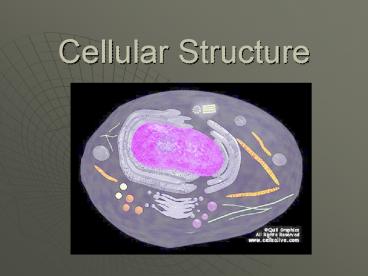Cellular Structure - PowerPoint PPT Presentation
Title:
Cellular Structure
Description:
Cellular Structure Nucleus The control center of the cell (metabolism, protein synthesis) Nucleus: FYI Most cells contain only one nuclei; Skeletal muscle = many ... – PowerPoint PPT presentation
Number of Views:118
Avg rating:3.0/5.0
Title: Cellular Structure
1
Cellular Structure
2
Nucleus
- The control center of the cell (metabolism,
protein synthesis)
3
Nucleus FYI
- Most cells contain only one nuclei
- Skeletal muscle many
- Mature RBCs none
4
Nucleolus
- Dense region that contains DNA/RNA
- Synthesizes RNA and ribosomes
5
Cytoplasm
- The watery fluid which contains the materials
which enter the cell. - Dissolves things, supports cell structure.
6
Cytoplasm
- Three parts
- 1. Cytosol (liquid)
- 2. Organelles (little organs)
- 3. Inclusions (insoluble particles)
7
Organelles
- Intracellular structure that performs a specific
function or group of functions. (cellular
respiration, releasing energy)
8
Mitochondria
- The powerhouse of the cell.
- They create food to obtain energy for cell
activities. - Produces 95 of ATP
9
Mitochondria
- of mitochondria energy level needed
10
Matrix
11
Cristae
- Lots of folds in mitochondria
12
- The cristae greatly increase the inner membrane's
surface area. It is on these cristae that food
(sugar) is combined with oxygen to produce ATP -
the primary energy source for the cell.
13
Ribosomes
- Makes proteins in the cell. Protein factories-
aka. protein synthesis - Contains RNA
14
Ribosomes
- Free-floating
- Proteins are made and enter in the cytosol
- Fixed
- Proteins enter ER where they are modified and
packaged for export.
15
Endoplasmic Reticulum (ER)
- Synthesis
- Storage
- Transport
16
Synthesis
- ER makes
- Carbohydrates
- Lipids
17
Storage
- Storage of molecules that are absorbed from the
cytosol.
18
Transport
- Network of membranes. (Travel anywhere)
19
Smooth (SER)
- Lack ribosomes (smooth)
- Focus on making carbohydrates and lipids
20
Rough (RER)
- Contain ribosomes (hence rough)
- Focus on making proteins
21
Golgi Apparatus
- Package proteins for storage and secretion from
the cell. - Exocytosis, package particles (forms lysosomes)
22
Golgi Apparatus
- Page 55 of text.
- Example of exocytosis and membrane reconstruction.
23
Lysosomes
- Digest worn out or unneeded cells and cell parts.
24
Lysosomes
- Packages of digestive enzymes.
- Fight pathogens
- Why?????
25
Specialized Structures
- Organelles that are not common to all cells,
therefore they are not necessary for the cell to
operate.
26
Microtubules
- Hollow tubes that give support and strength
27
Centrosome
- The centrosome, also called the "microtubule
organizing center", is an area in the cell where
microtubles are produced.
28
Cilia
- Hair-like microtubules attached to the plasma
membrane that often help in movement
29
Flagella
- A tail like structure used for movement
30
Microvilli
- Extension/folding of membrane to help increase
surface area. - Found in kidney and intestinal cells.
31
- http//www.stolaf.edu/people/giannini/flashanimat/
cellstructures/endomembrane20protein20synthesis.
swf - http//www.wisc-online.com/objects/index_tj.asp?ob
jIDAP11403
32
S
M
T
U
K
N
P
Q
O
L
33
AKA cell membrane
34
COLOR CODE (Page 52 new)
- Glycoproteins (Globular) G
- Channel H
- Phospholipids Heads A
- Fatty acid tails S
- Carbohydrate (sugar)
35
1. Hydrophobic
- Dislike Water
- Two fatty acid tails
36
2. Hydrophilic
- Likes Water
- Non-lipid head
37
- http//www.stolaf.edu/people/giannini/flashanimat/
lipids/membrane20fluidity.swf
38
- The lipid tails will not associate with water
molecules, and this allows the cell membrane to
act as a physical barrier. The phospholipid
bilayer also contains cholesterol, which makes
the bilayer stronger, more flexible and
permeable.
39
3. Glycoprotein (Channel Carrier)
- Globular proteins have a structural role as well
as a role in transporting ions in and out the
cell-they are rounded and compact.
40
4. Receptor Proteins
- Receptor Proteins are found on the bilayer, deal
with communication, recognition and transport. - Ex Binding of insulin Tell cell to increase
intake of glucose.
41
(No Transcript)
42
5. Carbohydrates Lipids
- Are found on the outer surface of the cell and
have 3 major roles - 1. important cell lubricants and adhesives
- 2. act as receptors for exracellular compounds
- 3. part of a recognition system that keeps the
immune system from attacking its own tissues.
43
Plasma Membrane (review)
- Controls what enters and leaves the cell. It
contains the cell contents and protects the cell.
- composed of lipids
- hydrophobic lipid ends facing inward and the
hydrophilic phosphate ends facing outward. Also
called lipid bilayer.
44
Functions of cell membrane
- The cell membrane or plasma membrane has four
basic functions.
45
Functions of cell membrane
- 1. Boundary between cell fluids
- Cytoplasm vs. extracellular fluid.
46
- 2. Regulation of exchange
- Selects what goes in and what goes out (ions,
waste, etc)
47
- 3. Communication
- Senses environment and adjusts.
48
- 4. Structural Support
- Gives cell support and shape.































